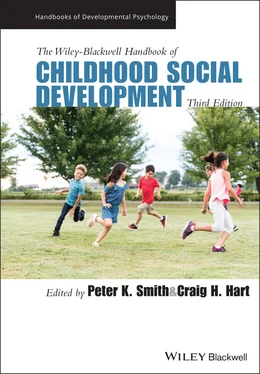Charles N. Oberg,University of Minnesota, Minneapolis, MN, USA
Mónica Ojeda,University of Seville, Seville, Spain.
Karina V. Padilla Malca,The University of Edinburgh, Edinburgh, Scotland
Amy L. Paine,Cardiff University, Cardiff, Wales
Alison E. Parker,Innovation Research & Training (iRT), Durham, NC, USA
Michal Perlman,University of Toronto, Toronto, Canada
Narcisa Prodan,Babeş‐Bolyai University, Cluj‐Napoca, Romania
Eric E. Rasmussen,Texas Tech University, Lubbock, USA
Holly Recchia,Concordia University, Quebec, Canada
Amanda J. Rose,University of Missouri, Columbia, MO, USA
Hildy S. Ross,University of Waterloo, Waterloo, ON, Canada
Kenneth H. Rubin,University of Maryland, College Park, USA
Ann Sanson,University of Melbourne, Victoria, Australia
Ayşe Bilge Selçuk,Koç University, Istanbul, Turkey
Kelly A. Smith,University of Maryland, College Park, MD, USA
Rhiannon L. Smith,University of Connecticut, Storrs, CT, USA
Peter K. Smith,Goldsmiths College, University of London, London, UK
Allie Spiekerman,University of Missouri, Columbia, MI, USA
Elisabeth Staksrud,University of Oslo, Oslo, Norway
Elizabeth A. Steed,University of Colorado Denver, Denver, CO, USA
Cara S. Swit,University of Canterbury, Christchurch, New Zealand
Victoria Talwar,McGill University, Quebec, Canada
Sandie Taylor,University of South Wales, Newport, Wales
Stephanie A. Thibault,Arizona State University, Tempe, AZ, USA
Judith Van Hoorn,University of the Pacific, Stockton, CA, USA
Suman Verma,Panjab University, Chandigarh, India
Laura Visu‐Petra,Babeş‐Bolyai University, Cluj‐Napoca, Romania
Mary Ellen Voegler‐Lee,University of North Carolina at Chapel Hill, Chapel Hill, NC, USA
Katharina Voltmer,Leuphana University Lueneburg, Lueneburg, Germany
Maria von Salisch,Leuphana University Lueneburg, Lueneberg, Germany
Sara S. Whipple,Virginia Military Institute, Lexington, VA, USA
Linda A. White,University of Toronto, Toronto, Canada
Lance Workman,University of South Wales, Newport, Wales
H. Melis Yavuz‐Müren,University of Toronto at Mississauga, Ontario, Canada
Kathryn M. Yee,University of Maryland, College Park, MD, USA
Peter K. Smith and Craig H. Hart
This is the third edition of this Handbook, which has proved to be a successful volume in a successful series. In editing this third edition, we have sought to maintain the strengths of the first (2002) and second (2011) editions, update and further strengthen the breadth of coverage, and provide an advanced text which will be useful to many individual researchers, as well as an indispensable library resource. Many features are in common with the first and second editions, but there are some distinctive new features.
This volume is part of a series, and there are companion volumes on infancy; on cognitive development in childhood; and on adolescence. Thus, the age range covered in this volume is broadly from post‐infancy (around 3 years) up to adolescence. It does not include material on infancy, or adolescence and beyond, except in so far as it might be necessary for understanding or contextualizing the theories, methods, and findings of the research in childhood. Of course, a wide age range remains, from preschool (3–5 years), early school (5–7 years) through to later elementary or middle school (8–11 years). Also, the chapters focus on social development. This includes several chapters in the social cognition area, in Part IX.
We asked for chapters at a certain level. Thus this Handbook is not meant for beginners in the area. Those who have not studied child development previously will be better served by one of the many introductory texts available. The brief we gave to authors was to give a clear and succinct account of work in their area, which would be suitable for anyone wishing to go beyond basic textbook coverage. This would include advanced undergraduates in psychology and behavioral sciences, and postgraduates taking taught or research‐focused master’s degrees, or pursuing doctoral research. It will also include teaching staff and researchers who wish for an authoritative update outside their immediate teaching/research area. The book should also be useful for those professionals outside academic life – for example, educators, social workers, counsellors, probation officers – who have had training in the behavioral sciences and retain an active interest in the implications of research for their professional practice.
As in the first and second editions, we attempted – and feel we have succeeded – to get a very good geographical coverage of contributors. Much of the work in our domain does come from North America, and it is appropriate that the largest single country contributing authors is the United States. However, it is also appropriate that we have contributors from Australia, Belgium, Canada, Costa Rica, England, Germany, Hong Kong, Hungary, India, Ireland, Italy, the Netherlands, New Zealand, Norway, Rumania, Scotland, Spain, Switzerland, Taiwan, Turkey, and Wales. This reflects the now very international community of child development researchers, and is an even broader spread than we had in 2002 and in 2011.
Regardless of their origin, we asked our contributors to be clear and succinct, but also interesting and where appropriate, challenging. In our letters of invitation we asked authors to “provide authoritative reviews of focused areas in social development, which both summarize existing knowledge, and highlight areas of debate and growing points in the discipline.” We worked with authors, sometimes intensively, to try to ensure that this was achieved.
For this new edition, while we retained some contributors from the second edition, well over half are new contributors. In all cases we pointed out that this new edition was being designed to capture emerging trends in the study of childhood social development as well as to provide updated insights on traditional topics covered in the first and second editions. We have several extra chapters; 42, compared to 34 in the second edition and 30 in the first edition, and two extra Parts making 11 in all.
Notable new features include a chapter on conflict, war, and famine as they affect children’s social development; a chapter on the impact of the climate crisis; and a chapter on the impact of the Covid‐19 pandemic, still an active concern at the time of writing. We have an extra chapter on acculturation and children’s social development; a new chapter on social development of youth in sport; and one on the impact of faith and religion. Another new topic covered is lies and deception in relation to social development; plus, we now have two chapters dedicated to the influence of the media and social networking sites.
We have 11 Parts in this new Handbook. Part Iis a single chapter, as before, providing an historical overview of psychological research in social development; because of the foundational importance of this topic, this is effectively a double‐length chapter. Part II(six chapters) covers different disciplinary perspectives – from behavior genetics, brain development, evolution, history, sociology and anthropology. Part III(five chapters) is on ecological contexts for social development, the physical environment, conflict, war, and famine, the climate crisis, and the Covid‐19 pandemic. Part IV(three chapters) is on culture and immigration, including a focus on Asian and Latinx children in the United States, and studies in Europe. Part V(three chapters) is on child characteristics – temperament, gender, and ethnicity. Part VI(four chapters) is on contextual factors – child care experience, interpersonal skills in school, sport, and religion. Part VII(three chapters) is on parents, siblings, and the interplay between families and peers. Part VIII(seven chapters) focuses on forms of peer interaction including friendships, shyness, social competence, play, cooperation and competition, aggression, and bullying. Part IX(four chapters) covers social cognition, emotions, prosocial behavior, and lies and deception. Part X(two chapters) is on children and the media generally, and social networking sites specifically. Finally Part XI(four chapters) covers interventions in relation to social development, generally and for children with autism, children with disabilities, and finally for children in low‐and middle income countries. In short introductions to each Part we highlight particular areas of debate or contrasting perspectives among the chapters.
Читать дальше












